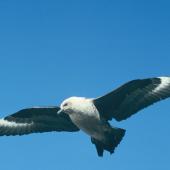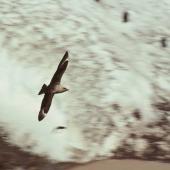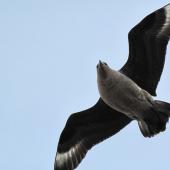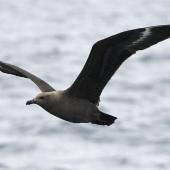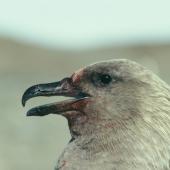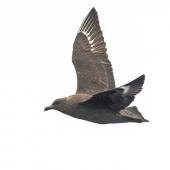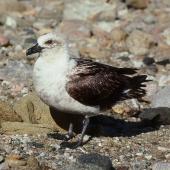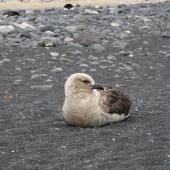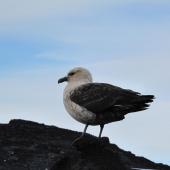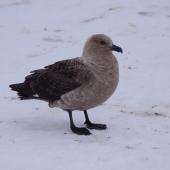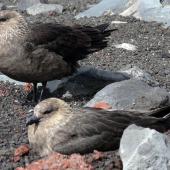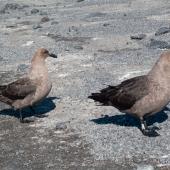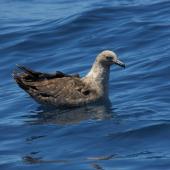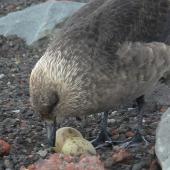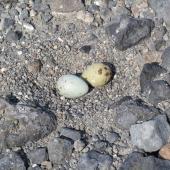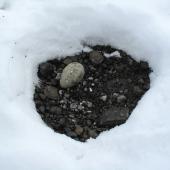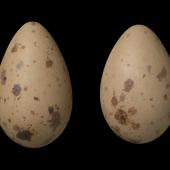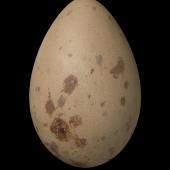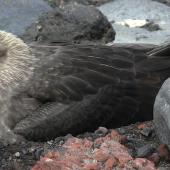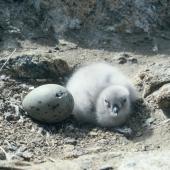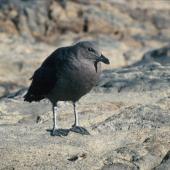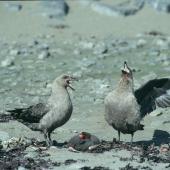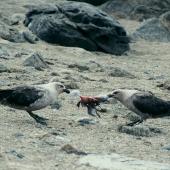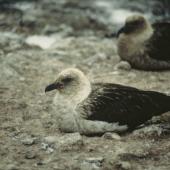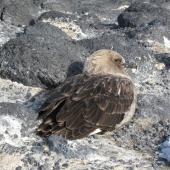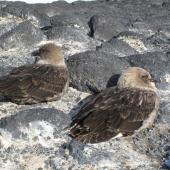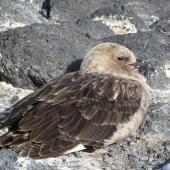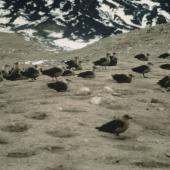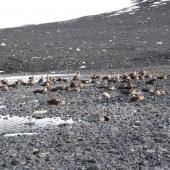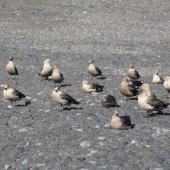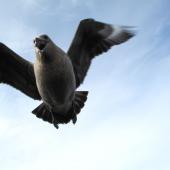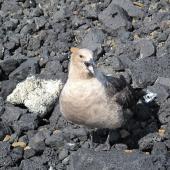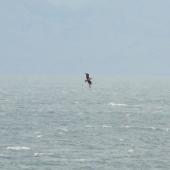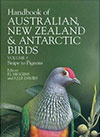South Polar skua
Stercorarius maccormicki Saunders, 1893
Order: Charadriiformes
Family: Stercorariidae
Other names: Antarctic skua, McCormick's skua
Geographical variation: As with the subantarctic skua, taxonomy is disputed by experts, with some designating the genus as Catharacta, others as Stercorarius. A polymorphic skua, with no determined geographical basis to the circumpolar distribution of its three morphs. In the South Orkneys, South Shetlands and Antarctic Peninsula, it occurs alongside and hybridises with the subantarctic skua, but this is an unlikely complication with skuas seen in the New Zealand region.
The South Polar skua is, alongside the southern giant petrel, a top avian predator in the Antarctic. It breeds south of 60° in Antarctica, including the Ross Sea region, which as the Ross Dependency is territory claimed by New Zealand. The first specimen was collected from Possession Island in the Ross Sea in 1841 during James Clark Ross’ Antarctic expedition by surgeon-naturalist Robert McCormick, after whom it was named.
Identification
The South Polar skua is smaller than the subantarctic skua, and has a stubbier bill. It occurs in three plumage morphs: a pale morph in which the bird may have an overall soft buff to honey colouration with dark wings; a dark morph of chocolate brown; and an intermediate morph of grey-brown with dark wings. Paler birds often have a yellowish patch on the nape. All have a whitish outer-wing patch.
Voice: the distinctive territorial display with raised ‘Viking helmet’ wings is accompanied by a raw descending ‘ah-ah-ah’ long-call, which sounds ‘cracked’ in comparison with same call from subantarctic skua. Quack-like anxiety calls are given on the ground in territory. The alarm call, which may start on the ground and continue during repeated high-speed stoop attacks on intruder (skua, human, seal – but not penguins) is an ear-splitting scream. The alarm call is often initiated by the incubating bird, which triggers alarm calls (and attack) by the partner. Otherwise quiet in flight and at sea.
Similar species: in the New Zealand region, dark morph birds most likely to be confused with the larger subantarctic skua; the two species are very similar unless direct size comparison is possible. Juvenile southern black-backed gulls are more slightly built, and have narrower wings lacking a whitish outer-wing patch.
Distribution
South Polar skuas breed only in Antarctica, where they have a circumpolar distribution (though possible absent from the Balleny Islands and Scott Island in the northern Ross Sea). They breed along Victoria Land coast and islands, including Ross Island, in the Ross Sea. It departs Antarctica each winter and disperses widely across the Atlantic and Pacific, including New Zealand waters. The South Polar skuas have the greatest latitudinal range of any bird, having been recorded at the South Pole and (during its annual migrations) the coasts of Japan, British Columbia and Greenland.
Habitat
When not breeding, South Polar skuas live entirely at sea. Preferred breeding habitat is coastal ice-free areas, often near Adelie penguin colonies or petrel breeding grounds. They may also breed at inland nunataks, sometimes in association with breeding Antarctic or snow petrels upon which they prey. Non-breeding and ‘off-duty’ skuas aggregate at non-territorial ‘clubs’, often near meltwater pools, or on beaches.
Population
The Ross Sea population is estimated at 15,000 individuals.
Threats and conservation
At sea, possible risk of fisheries ‘by-catch’, particularly in areas beyond New Zealand Exclusive Economic Zone where ‘pirate’ fishing may occur without mitigation techniques. At Antarctic breeding grounds, risks potentially arise from human activity, including research and tourism disturbance, and competitive use of ice-free areas for construction of stations and airstrips. Access to open water for feeding may be affected by unusual ice or iceberg events. Overall, the greatest threat for South Polar skuas is likely environmental impacts of climate change on marine productivity.
Breeding
South Polar skuas are monogamous, with shared incubation, brooding, chick-feeding and defence. Nests are bare scrapes. Two large pale-green mottled eggs are laid November-December. Incubation takes 26-34 days, and chicks fledge after 45-50 days. The majority of adults and juveniles depart breeding grounds in March.
Behaviour and ecology
South Polar skuas are present at their breeding grounds only during the summer. Their ecology and behaviour reflects the short Antarctic season. The birds are intensely territorial during the breeding season and, likely constrained by available terrain, occupy generally smaller territories than subantarctic skuas.
Food
South Polar skuas feed at sea during the winter, taking prey and debris on or just below sea-surface. During the breeding season in the southern Ross Sea the most important prey are Antarctic silverfish, Pleuragramma antarcticum. South Polar skuas also take eggs and chicks of Adelie penguins and (where available, particularly at inland nunataks) petrels.
Weblinks
References
Heather, B.D.; Robertson, H.A. 1996. The field guide to the birds of New Zealand. Viking, Auckland.
Higgins, P.J.; Davies, S.J.J.F. (eds.) 1996. Handbook of Australian, New Zealand and Antarctic birds. Vol. 3. Snipe to Pigeons. Oxford University Press: Melbourne.
Young, E.C. 1994. Skua and penguin: predator and prey. Cambridge University Press: Cambridge.
Recommended citation
Hemmings, A.D. 2013 [updated 2022]. South Polar skua. In Miskelly, C.M. (ed.) New Zealand Birds Online. www.nzbirdsonline.org.nz
South Polar skua
- Social structure
- monogamous
- Breeding season
-
- Jul
- Aug
- Sep
- Oct
- Nov
- Dec
- Jan
- Feb
- Mar
- Apr
- May
- Jun
- Nest type
- scrape
- Nest description
- Small depression
- Nest height (mean)
- 0 m
- Maximum number of successful broods
- 1
- Clutch size (mean)
- 1-2
- Clutch size (min)
- 1
- Clutch size (max)
- 2
- Mean egg dimensions (length)
- 71 mm
- Mean egg dimensions (width)
- 50 mm
- Egg colour
- Pale green, mottled
- Egg laying dates
-
- Jul
- Aug
- Sep
- Oct
- Nov
- Dec
- Jan
- Feb
- Mar
- Apr
- May
- Jun
- Interval between eggs in a clutch
- 4 days days
- Incubation behaviour
- shared
- Incubation length (mean)
- 26-34 days
- Incubation length (min)
- 26 days
- Incubation length (max)
- 34 days
- Nestling type
- semi-precocial
- Nestling period (mean)
- 1 day
- Age at fledging (mean)
- 45-50 days
- Age at independence (mean)
- 50-60 days
- Age at first breeding (typical)
- 6-9 years
- Maximum longevity
- Possible >25 years
- Maximum dispersal
- 17,000 km





